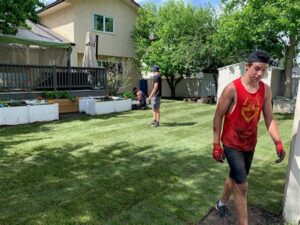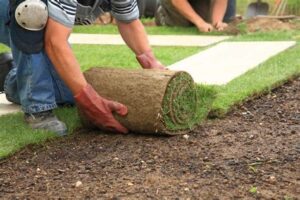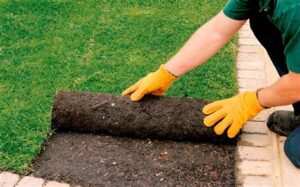Transforming your yard into a lush, green oasis has never been easier with professional sod installation. If you’re considering giving your lawn a fresh look, understanding what to expect during the process is essential for achieving the best results. From the numerous benefits of having sod installed—like instant greenery and improved curb appeal—to the preparations needed for a successful installation, we’ll cover everything you need to know. Additionally, we’ll guide you through the sod installation process, offer tips for post-installation care, and address common challenges you may face. So whether you’re a seasoned gardener or a first-time homeowner, this comprehensive guide will ensure your sod installation experience is smooth and rewarding. Let’s dive into the details!
Understanding The Benefits Of Getting Sod Installed
When you choose to have sod installed on your lawn, you’re opting for a quick and effective solution to achieving a lush, green landscape. This method of establishing a lawn offers numerous advantages that go beyond just aesthetics. Here are some key benefits of getting sod installed:
| Benefit | Description |
|---|---|
| Instant Gratification | Unlike traditional seeding methods, sod installed provides an immediate green space, allowing you to enjoy your lawn right away. |
| Soil Erosion Prevention | Newly laid sod helps stabilize the soil, significantly reducing the risk of erosion before grass becomes established. |
| Weed Control | With sod installed, there’s less chance of weeds taking root because the thick layer of sod can outcompete most weeds initially. |
| Environmental Benefits | Sod not only enhances the beauty of your property but also improves air quality, provides oxygen, and helps with stormwater management. |
| Customized Lawn Choices | Choosing sod allows you to select specific grass types suited to your climate and aesthetic preferences, ensuring a tailored result. |
Overall, the decision to have sod installed is a strategic one that yields immediate and long-term benefits. This investment in your lawn not only enhances the visual appeal of your property but also contributes positively to the environment and your outdoor enjoyment.
Preparing Your Lawn For Successful Sod Installation
Before getting sod installed: it’s crucial to prepare your lawn properly to ensure the best results. The right preparation can make a significant difference in the success of your new sod. Here are some steps to follow:
By following these preparatory steps, you’ll create a healthy foundation that enhances the success of your sod installed: lawn. The better your preparation, the more vibrant and resilient your sod will be once installed.
The Process Of Having Sod Installed On Your Property
When you decide to have sod installed: on your property, it’s essential to follow a structured process to ensure the best results. Here’s a step-by-step breakdown of what to expect during the installation process:
1. Site Assessment: Before any installation can occur, a professional will assess your lawn. This includes evaluating soil quality, sunlight exposure, and existing vegetation. This assessment helps determine the type of sod that will thrive in your conditions.
2. Soil Preparation: Proper soil preparation is crucial. This step may involve removing old grass, weeds, and debris. The soil is then tilled to about six inches deep to improve aeration and drainage. Additionally, testing the soil pH and nutrient levels may lead to amendments, ensuring optimal conditions for the new sod.
3. Grading the Lawn: To prevent water pooling, grading your lawn is necessary. This process ensures that the surface is level and directs water towards drainage areas. Proper grading also aids in the establishment of the new sod.
4. Installing the Sod: Once the preparation is complete, the sod installed: can begin. The sod pieces are laid out in a staggered pattern, similar to a brick wall, which helps them establish better. Each piece should fit snugly against the next to eliminate gaps that can lead to water loss.
5. Rolling the Sod: After laying the sod, it is rolled using a lawn roller. This helps establish contact between the sod roots and the soil, improving root penetration and reducing air pockets.
6. Watering: Immediately after installation, the new sod requires a thorough watering. Keeping the sod consistently moist during the first few weeks is critical for root establishment. An efficient watering schedule should be established to avoid over- or under-watering.
Throughout this process, communication with your sod installation professional is important to ensure that any specific needs or concerns are addressed. Following these steps will help you achieve a lush, healthy lawn with your newly sod installed:
Post-Installation Care For New Sod Installed
Once your sod is installed, proper care is crucial for ensuring a healthy and vibrant lawn. The initial weeks after installation play a pivotal role in helping the sod establish strong roots. Here are some essential care tips:
- Watering: Immediately after installation, your new sod will need to be watered thoroughly. In the first two weeks, aim to keep the soil beneath the sod consistently moist, watering lightly 1-2 times per day. Gradually reduce the frequency as the roots begin to anchor into the soil.
- Mowing: Delay mowing until the sod is firmly rooted, which typically takes about 2-3 weeks. When you do mow, set the blades high to avoid stressing the young grass.
- Fertilizing: After about 4-6 weeks, consider applying a starter fertilizer to promote healthy growth. Ensure it’s a balanced fertilizer formulated for new sod.
- Aeration: Avoid walking on your new sod as much as possible during the first few weeks. This will prevent damaging the sod and help it establish itself better.
- Weed Control: Keep an eye on weeds, but avoid using chemical herbicides until the sod has rooted well, usually around 6-8 weeks post-installation. Use hand weeding or mulching as initial weed control methods.
- Monitoring: Regularly check for signs of stress in the sod, such as browning or thinning patches. Early intervention can help address any underlying issues.
By following these guidelines, your new sod installed will thrive and provide a lush green space for you to enjoy. Consistent care during the early stages is key to a long-lasting lawn.
Common Challenges With Sod Installed: And Their Solutions
While having sod installed: on your lawn can significantly enhance its appearance and functionality, several challenges may arise during and after the installation process. Below are some common issues homeowners face and practical solutions to tackle these problems.
1. Poor Soil Preparation
If the soil isn’t properly prepared before sod installation:, it can hinder growth and lead to patchy areas. Ensure soil is tilled, aerated, and free of debris.
Solution:
Conduct a soil test to determine nutrient levels and pH balance. Amend the soil with organic matter like compost to create an optimal environment for sod.
2. Inadequate Watering
Newly installed sod requires regular watering for establishment. Without sufficient moisture, the sod can dry out and die.
Solution:
Water the sod immediately after installation and maintain a schedule of daily watering for the first two weeks. Gradually reduce frequency as the roots take hold.
3. Pest Infestation
New sod can attract pests, which may damage the grass and prevent healthy growth.
Solution:
Regularly inspect your lawn for signs of pests. Employ natural pest control methods or consult a professional if infestations become severe.
4. Uneven Growth
Discrepancies in growth can occur due to differences in sunlight, soil conditions, or drainage issues.
Solution:
Monitor the sod regularly, and adjust your care routine accordingly. If certain areas are underperforming, consider overseeding or adjusting soil conditions.
5. Disease Development
New sod can be susceptible to diseases, especially in humid or wet conditions.
Solution:
Ensure proper air circulation and avoid watering during the hottest parts of the day. Apply fungicides as a preventive measure if necessary.
By being aware of these challenges and how to address them, you can maximize the benefits of sod installed: and enjoy a vibrant, healthy lawn for years to come.
Frequently Asked Questions
What is sod and why is it used for lawns?
Sod is a type of grass that is grown with soil and roots intact, sold in rolls or squares. It’s used for lawns to establish an instant green cover, reduce soil erosion, and provide an immediate aesthetic appeal.
What preparations should be made before sod installation?
Before installing sod, it’s important to prepare the soil by clearing debris, leveling the area, ensuring proper drainage, and testing the soil for nutrient levels. Amending the soil with compost or fertilizer may also be beneficial.
How long does it take for newly installed sod to take root?
Newly installed sod typically takes about 2 to 3 weeks to establish roots. During this time, it’s crucial to keep the sod adequately watered and avoid heavy foot traffic.
What is the best time of year to install sod?
The best time to install sod is during the cooler months of early spring or early fall when temperatures are mild, allowing for optimal growth and root establishment without the stress of extreme heat.
How should I water my newly laid sod?
Initially, new sod should be watered thoroughly, ensuring the top inch of soil remains consistently moist. A deep watering is recommended every other day for the first two weeks, gradually shifting to less frequent, deeper watering as the roots establish.
Can I mow my sod immediately after installation?
It’s advisable to wait until your sod has rooted properly, generally about 2 to 3 weeks, before mowing. Ideally, wait until the grass reaches a height of about 3 to 4 inches before the first cut.
What maintenance is required after sod installation?
After installation, regular maintenance includes watering, fertilizing, mowing, and monitoring for pests and diseases. It’s important to continue caring for the lawn to ensure healthy growth and resilience.





